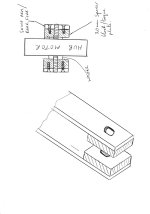Jessiedog1234567
10 mW
- Joined
- Sep 21, 2017
- Messages
- 26
I want to put a 48v 800w brushless hub motor onto the rear wheel of a small kids motorbike. The hub motor axle does not reach the full width of the swing arm (rear forks) and so I will need to space this out with aluminium or steel blocks fixed to the inside of the swing arm which the axle will locate into. At the same time I need to make a torque plate(one each side) to stop the axle spinning. My question is if I machine these spacing blocks, that will be about 20mm thick each, so that they act as both spacers and torque plates will aluminium be resistant enough (the axle shaped hole itself) to stop the axle spinning taking into consideration the thickness of the blocks or would they be better made of steel.
Aluminium would be much easier to machine .
I attach a very amateurish drawing of the kind of thing I mean.

Aluminium would be much easier to machine .
I attach a very amateurish drawing of the kind of thing I mean.



